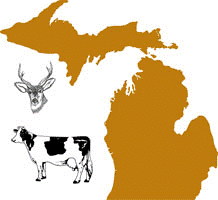Wildlife Disease and Zoonotics
Abstract
Bovine tuberculosis (TB) is an infectious and communicable granulomatous disease caused by the acidfast bacilli bacteria of Mycobacterium bovis (M. bovis). It is commonly a chronic, debilitating disease, but occasionally may assume an acute, rapidly progressive course. M. bovisis a widespread zoonosis that is global in magnitude and affects nearly all species of vertebrates (cattle, sheep, goats, pigs, bison, buffalo, and camelids.) Disease is spread by direct contact, inhalation of infected droplets expelled from infected lungs, and ingestion of contaminated feed or milk. In most countries, TB is a notifiable disease. Overall, TB has an important world-wide impact on animal industries and human health. Control measures are based on prevention and eradication. Surveillance is a key element for management of preventions and control programs.
Surveillance for TB serves the purpose of enabling Veterinary Services to obtain an accurate picture of the scope of the disease in the US livestock populations; in the event of a disease outbreak, the course TB follows in livestock and wildlife populations for a given area over time; and permits timely intervention if the trend observed deviates from what is expected.


